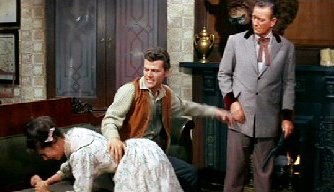feminist friendly: is spanking okay?
Before 50 Shades of Grey inspires you to go paddle shopping, I feel like I should butt in (see what I did there?). It’s actually kind of hard to tell whether spanking is:
(a) the mark of a free woman who apologises to no one in search of her own pleasure, or
(b) the patriarchy rearing its ugly head, infantilising women and (in heterosexual relationships) putting a man in a position of power.
Spanking inspires feelings of servitude and helplessness – that’s what’s so sexy about it. Or not, depending on which camp you’re in. While that helplessness may be mixed in with love for your partner and a keenness for something new in the bedroom, a man lusting after a woman’s servitude is nothing new. In fact, it’s pretty old hat.
Spanking has had a rich history. In the 18th century it was used as a disciplinary measure for sailors. Back then it was called cobbing. In the 19th century, “paddling” was used in America to punish slaves in a way that wouldn’t scar them and reduce their value, which may be the worst thing I’ve ever learnt.
The 20th century spank had a different purpose (other than military initiation): discipline in the home. What was once called “domestic discipline” was actually a form of punishment administered to wives and children. It was thought, and unfortunately in some circles still is, that it is a husband’s duty to put his wife and children in line. This is abuse and it is not okay.
But despite this, spanking as a form of punishment has been widely depicted in popular culture. Lucy’s husband on ’50s TV series I Love Lucy spanks her on multiple occasions for her “meddling”. Lucy yells, tries to get away and holds her butt in pain as the audience laugh track plays.
Even when reversing the gender norms when women become the spankers, the act feeds into a history of oppression. A woman spanking a man is erotic because it’s unusual. It’s fetishised that a man would want to be humiliated and degraded by a woman, because that isn’t a part of our collective spanking history. Even though this role reversal could be seen as transgressing norms, it enforces the pretence that one individual has to be dominant and disciplining and therefore inhibits gender equality.
Spanking can feel empowering: it allows women to demand sexual satisfaction. But we need to examine why women feel comfortable asking to be spanked but may struggle to, for example, let their pubic hair be free. Spanking does not challenge the status quo of male dominance. It reinforces it. So perhaps it’s best we move on and leave that history behind. (Sorry, I couldn’t help myself.)



Woah, this was an uncomfortable read – and those first clips were mildly disturbing. Ergh. I like that you’re examining a trend within the wider cultural context: is this just another action in individual lives or is it compelled by a culture of male dominance?
This makes me think of a PostSecret card I once saw: ‘I’m a feminist and I completely disagree with all the things that turn me on in the bedroom.’
Well done on a super one-dimensional, kink-shaming article that mutes the complexities of fetish and ends up being another piece of media telling women how to think, feel and act. So refreshing.
Wow, what a disappointing article from a usually progressive and thoughtful magazine.
Yes, we need to think critically about the roots of our sexual desires and attractions. No, we do not need to be told in the most heteronormative, one-dimensional, kink-shaming way possible that we need to “move on” from spanking as a whole because the act of spanking has in the past been used in an oppressive context.
First of all, the author obviously has an extremely limited knowledge of the kink scene and community. If she’d done some research on the people who actually participate in kink activities she would know that actually, within the scene, there are far more men than women who are subs. Next, the mantra of the kink community at large is “safe, sane, consensual.” That means that anything that takes place outside of those boundaries is not kink, it is abuse. While abuse definitely happens within fetish communities and this is a subject that absolutely needs addressing, that’s not the topic at hand right now.
I am a queer woman, and I enjoy both spanking (and similar things like flogging and caning) and being spanked etc. I found this article to be a complete erasure of people like me who do not partake in male dom/female sub sex or kink play (which as I mentioned above is actually a minority within kink spaces) and dismissive of the varied, complex and personal reasons people enjoy these activities.
Next time, maybe try and do even a modicum of research into the topic you’re writing about, rather than writing a knee-jerk, sensationalist op-ed about inaccurate pop culture representations of fetish instead of, you know, actual fetish communities.
Why can’t people just leave each other alone and let them do what they want to do ? The 16 year old boy has sex with his teacher (consentially) and we say it’s wrong while they don’t. The gays want the freedom to be married, but want to deny they same freedom to the limosine driver who doesn’t want to work their gay wedding. Hello … why don’t you just back off? Is freedom only for you and your friends?